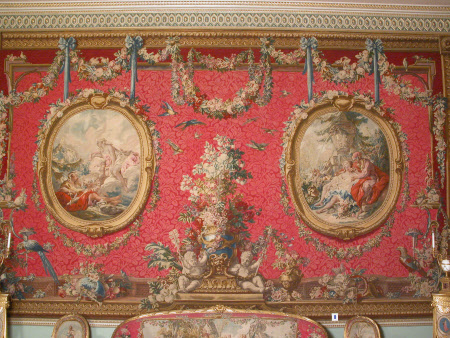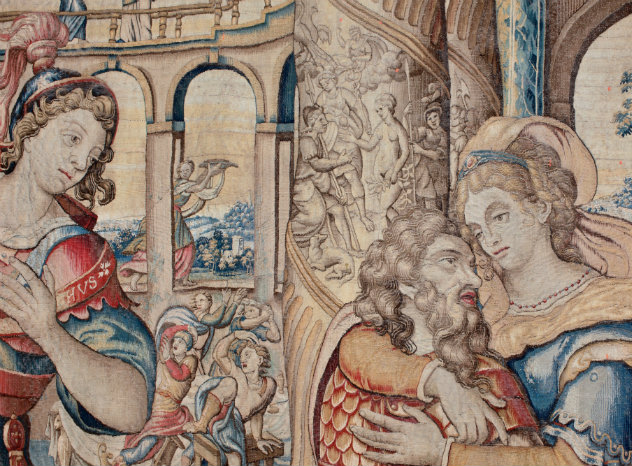Tenture de Boucher: Aurora and Cephalus and Vertumnus and Pomona
Manufacture des Gobelins
Category
Tapestries
Date
circa 1775 - circa 1776
Materials
Tapestry, wool and silk, 8 warps per cm
Measurements
3.68 m (H); 2.11 m (W)
Place of origin
Paris
Order this imageCollection
Osterley Park and House, London
NT 772428.15
Summary
Tapestry, wool and silk, 8 warps per cm, Aurora and Cephalus and Vertumnus and Pomona from the Tenture de Boucher, Jacques Neilson workshop, Manufacture des Gobelins after a design by François Boucher, Maurice Jacques, Louis Tessier and Pieter Boel and conceived by Jacques-Germain Soufflot, 1775-76. This piece covers the north wall of the tapestry room. It is woven to imitate a wall with crimson silk damask wall hangings, carved and gilded mouldings around the edges, and two framed paintings hanging from blue ribbons in the centre. Garlands of flowers are suspended from the upper mouldings and draped around the frames of the paintings, and birds fly about against the damask walls. At the lower edge a stone plinth above the gilded moulding creates a foreground field on which sit elaborate pastoral trophies beneath the two paintings – bagpipes and a straw hat on the left, a hunting horn on the right, both surrounded by flowers. In the centre the gilded moulding along the bottom of the panel forms a stand for a large gilt-bronze-mounted vase of blue stone or porcelain, supported by two stone putti and filled with flowers, whole a smaller gilt vase stands to the right. Birds fly about against the damask background and perch on the ornaments and flowers, including a blue macaw at the lower left and a pheasant a the lower right. The paintings were both designed by François Boucher. On the left Aurora sits on a cloud gazing down on her sleeping beloved Cephalus, while on the right Vertumnus, in the guise of an old lady, seeks to seduce Pomona. Both woven paintings include the signature ‘F Boucher’, and on the gilded moulding at the bottom right the tapestry is signed ‘Neilson éx.’
Full description
Eighteen separate pieces of tapestry, ranging from narrow strips just a few inches wide to large panels covering entire walls, together completely line the walls of the Ante Room or Tapestry Room at Osterley. The tapestries were commissioned by Robert Child from the Gobelins Manufactory in Paris. They are dated 1775 and were delivered and installed in 1776. In addition to the wall hangings matching tapestry covers were woven for a suite of eight chairs and a settee (nos. 771776, 771777), and covers for a fire screen and chimney board (nos. 771870, 772429). The Ante Room was one of a series of three State Rooms designed by Robert Adam for Osterley between 1772 and 1776, and was one of the last rooms in the house to be completed. Although entirely woven in tapestry, the hangings at Osterley imitate a number of different media. The pink background is woven to create the effect of silk damask, and each panel has a frame resembling carved and gilded wood. The larger panels have stone plinths at the bottom, and paintings, complete with the woven signature of François Boucher, in gilded frames hanging from blue ribbons tied to the upper borders. The illusory silk, wood, stone and paint are augmented by flowers, hanging in garlands from the upper edges and strewn around the stone plinths, as well as various birds, animals and pastoral trophies. The design of the Osterley tapestry room is the result of collaboration between a number of different artists. The idea for a tapestry design based on a plain background woven to imitate silk damask, with paintings ‘framed’ with it, was conceived in the late 1750s by Jean-Germain Soufflot (1713-1780), the architect and director of the Gobelins, in collaboration with Jacques Neilson (1714-1788), the head of the ‘basse lisse’ (‘low warp’) workshop at the Gobelins. François Boucher, appointed designer in chief at the Gobelins in 1755, was responsible for the painted roundels in the tapestries, and the series became known as the ‘Tenture de Boucher’ (‘Tenture’ is the French word for a series of tapestry designs). The frames, plinths, urns, flowers and trophies were executed by Maurice Jacques, a decorative painter at the Gobelins, under Boucher’s supervision, and later elements were added by Louis Tessier. Most of the animals meanwhile were copied from a series of oil sketches executed by Pieter Boel (1622-1674) of animals in Louis XIV’s menagerie, and destined for use in a series of tapestries of the ‘Maisons du Roi’ (Royal Residences) woven for Louis XIV from the 1670s onwards. Boel’s oil sketches for the earlier tapestries had remained at the Gobelins and were simply re-used on this later tapestry series (for Boel’s sketches see Foucart-Walter 2001). The first weaving of the ‘Tenture de Boucher’ was commissioned in 1763 by the Earl of Coventry, and delivered and installed at Croome Court in 1771, and the entire room is now in the Metropolitan Museum, New York (Standen 1985, vol. I, pp. 385-401; Standen 1959). The Croome Court room included roundels after the first four paintings executed by Boucher for the series: ‘Aurora and Cephalus’, ‘Vertumnus and Pomona’, Neptune and Amymone’ and ‘Venus and Vulcan’, all stories are taken from Ovid’s ‘Metamorphoses’. The four scenes at Croome Court also served as allegories of the four elements, Air, Earth, Water and Fire respectively. At Osterley three of the roundels, ‘Vertumnus and Pomona’, ‘Aurora and Cephalus’ and ‘Venus and Vulcan’ repeat subjects used at Croome, and can be read as allegories of Air, Earth and Fire. The fourth roundel however, ‘Cupid and Psyche’, is after a painting not by Boucher but almost certainly by Clément Belle (1722-1806), who worked as a cartoon painter and designer at the Gobelins from 1755. ‘Cupid and Psyche’, which shows Psyche accidentally spilling wax on her sleeping lover, also seems to refer to the element Fire, leaving two allegories of Fire at Osterley but none of Water. The theme of Fire is continued in the small roundels of Cupids lighting flames on the panel to the left of the fireplace (no. 772428.16), and on the firescreen (no. 771870), leading some to conclude that the theme of the entire room is Fire, and that the other state rooms at Osterley stand for the other elements. Another possibility is that the theme of the room no longer specifically refers to the elements. A more general theme of love can be read in Boucher’s painted scenes and also in the many pairs of love birds on the decorative surrounds, and the pastoral trophies which include cupid’s arrows and a pierced heart. The Manufacture des Gobelins, where the tapestries were made, was established as a royal manufactory under Louis XIV and produced tapestries for the French crown and nobility. By the 1750s the Gobelins was in severe financial difficulties, partly due to the French crown’s failure to pay for commissioned work, but partly due to a more general decline in the demand for tapestry in France and elsewhere in Europe. The ‘Tenture de Boucher’ was conceived by Jacques Neilson and Jean-Germain Soufflot specifically as a response to these problems, in the hope that the design would attract new clients. Neilson, the entrepreneur in charge of the low warp workshop at the Gobelins which produced the tapestries, simultaneously introduced a number of technical innovations that improved the quality and lowered the cost of the tapestries his workshop produced. The design, and the fact that the tapestries could be modified to suit any size of room, appealed especially to British clients, and the room at Osterley was the fifth (and final) ‘Tenture de Boucher’ tapestry room to be installed in England in little over a decade. The first was for the Earl of Coventry at Croome Court, commissioned in 1763 and installed in 1771. The Croome commission was swiftly followed in the later 1760s by rooms for William Weddell at Newby Hall, Yorkshire (woven with a pink-grey background, and still in situ), Weston Park, Shropshire (with a pink background, still at the house but moved from its original position), and Moor Park, Hertfordshire (again with a pink-great background, this set is now largely dispersed). In all of these houses, as at Osterley, the architect Robert Adam was in some way involved. Helen Wyld, 2013
Provenance
As commissioned and installed under the direction of Robert Adam
Marks and inscriptions
On the right hand painting, lower right: f Boucher On the left hand painting, lower centre: f Boucher. On moulding at bottom right: Neilson éx.
Makers and roles
Manufacture des Gobelins , workshop Jacques Neilson Workshop, workshop François Boucher (Paris 1703 – Paris 1770), designer Maurice Jacques (c.1712 - 1784), designer Louis Tessier (1719/20-1781), designer Pieter Boel (Antwerp 1622 – Paris 1674), designer Jacques-Germain Soufflot (fl.1775-1776), designer
References
Harris, 2001: Eileen Harris, The Genius of Robert Adam. New Haven and London: Yale University Press, 2001 Foucart-Walter, 2001: Elizabeth Foucart-Walter, Pieter Boel, 1622-1674: Peintre des Animaux de Louis XIV. Le fonds des etudes peintes des Gobelins, exh. cat. Musée du Louvre, Paris 2001 Bremer-David, 1997: Charissa Bermer-David, French Tapestries and Textiles in the J. Paul Getty Museum, Los Angeles 1997 Standen, 1994: Edith A.Standen “Country Children: Some Enfants de Boucher in Gobelins Tapestry.” Metropolitan Museum Journal Vol. 29, (1994) pp.111-133 Harris, 1994: Eileen Harris, Osterley Park, Middlesex, London 1994 Standen, 1993: Edith Standen, ‘Madame de Pompadour's Gobelins tapestries’, Studies in the History of Art, vol. 42 (1993), pp. 14-33 Standen, 1988: Edith Standen, ‘Ovid's Metamorphoses: a Gobelins tapestry series’, Metropolitan Museum Journal XXIII (1988), pp. 149-191 Standen, 1985: Edith Appleton Standen, European post-medieval tapestries and related hangings in the Metropolitan Museum of Art, New York 1985 Tomlin, 1982: Maurice Tomlin. Catalogue of Adam period furniture. [2nd ed.]. London: [H.M.S.O. for] Victoria and Albert Museum, 1982. Harris, 1967: Eileen Harris, ‘The Moor Park Tapestries’, Apollo, vol. 86 (1967) Harris, 1962: Eileen Harris, ‘Robert Adam and the Gobelins’, Apollo, vol. 76 (1975), pp. 100-106 Standen, 1959: Edith Standen, ‘Croome Court: The Tapestries’, Metropolitan Museum of Art Bulletin, vol. 18, no. 3 (November 1959), pp. 96-111 Hussey, 1937: Christopher Hussey, ‘Newby Hall, Yorkshire – III’, Country Life, vol. 81 (26 June 1937), pp. 714-6 Fenaille, 1903-23: Maurice Fenaille, État general des tapisseries de la manufacture des Gobelins depuis son origine jusqu’a nos jours, 1600–1900, 4 vols., Paris 1903–23 Guiffrey, 1900: Jules Guiffrey, Les Modèles et le Musée des Gobelins, 3 vols., Paris 1900


